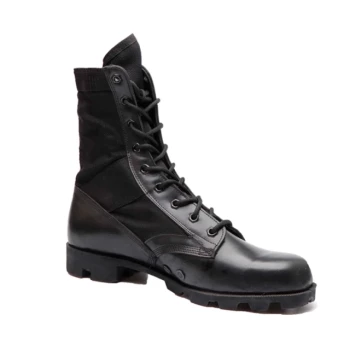When your job exposes you to electrical currents, slippery surfaces, or heavy falling objects, the right work boots aren't just about comfort—they're a critical defense against workplace injuries. This guide breaks down how to select boots with precise safety features aligned to your job's risks, backed by industry certifications like ASTM F2413-18.
Choosing Work Boots for Hazard-Specific Environments
Electrical Hazard Protection: Dielectric Materials and ASTM F2413-18 Certification
Key Takeaway: Boots designed for electrical hazards must block conductivity while meeting ASTM F2413-18 standards for shock resistance.
If you work near live wires or high-voltage equipment, look for:
- Non-conductive materials: Outsoles, heels, and shanks made of rubber or composite materials that prevent electricity from reaching your body.
- EH-rated insulation: ASTM F2413-18-certified boots undergo rigorous testing to ensure they resist electrical currents up to 18,000 volts in dry conditions (though actual protection levels vary by environment).
- No metal components: Avoid boots with steel toes or shanks unless they’re specifically insulated—composite toes are safer for electrical work.
Did you know? ASTM F2413-18 also tests for compression and puncture resistance, making EH-rated boots a practical choice for multi-hazard environments.
Outdoor and Industrial Terrains: Outsoles for Oil, Mud, and Extreme Slip Resistance
Key Takeaway: Slip-resistant outsoles use advanced tread patterns and rubber compounds to maintain grip on unstable surfaces.
For workers in oil fields, construction sites, or wet environments:
- Lug-style treads: Deep, multi-directional grooves channel mud and liquids away from the sole.
- Oil-resistant rubber: Compounds like nitrile outperform standard rubber in slick conditions.
- ASTM F2913 testing: Look for boots rated for "SR" (slip-resistant) or "SD" (slip-resistant on oil-covered surfaces).
Pro Tip: Pair slip-resistant soles with a waterproof membrane (e.g., Gore-Tex) if you frequently encounter puddles or rain.
Balancing Compliance and Comfort: Ergonomics in Safety-Toe Designs
Key Takeaway: Composite toes offer lighter weight and better flexibility than steel, but both must meet ASTM impact standards.
| Feature | Steel Toe | Composite Toe |
|---|---|---|
| Weight | Heavier (~20% more) | Lighter |
| Protection | Higher compression resistance | Meets same ASTM impact standards |
| Best For | Heavy industrial settings | Electrical work, cold climates |
Why it matters: Composite toes eliminate metal detectors’ hassle and reduce foot fatigue during long shifts. However, steel toes may be preferable for jobs involving extreme crushing hazards.
Put Safety First with 3515’s Hazard-Specific Work Boots
3515 designs work boots that align with your job’s unique risks—from dielectric insulation for electricians to oil-proof outsoles for warehouse teams. As a trusted manufacturer for distributors and bulk buyers, we combine compliance (ASTM, OSHA) with ergonomic engineering.
Ready to equip your workforce? [Contact 3515] for boots that meet exact safety specifications without sacrificing comfort.
Related Products
- Wholesale Customizable Suede Safety Boots - Puncture-Proof with Velcro Closure
- Puncture-Resistant Velcro Safety Boots for Wholesale & Custom Manufacturing
- Customizable Anti-Smash Safety Boots for Wholesale & Private Label Manufacturing
- Athletic Safety Shoes with Dial Closure & Steel Toe for Wholesale & Custom Manufacturing
- Wholesale Mesh Steel Toe Safety Shoes with Dial Closure Factory Production
Related Articles
- How to Choose Work Boots That Match Your Industry's Safety Needs
- Steel Toe Work Boots: Balancing Safety and Comfort for Demanding Jobs
- How to Choose Work Boot Materials for Maximum Safety and Durability
- How to Choose Work Boots That Balance Safety, Comfort, and Durability for Your Job
- Matching Men’s Work Shoe Safety Technologies to Workplace Hazards



















